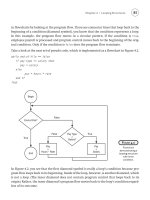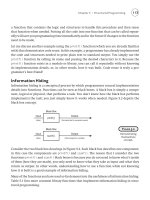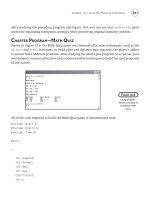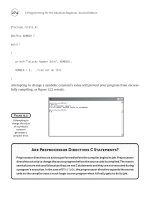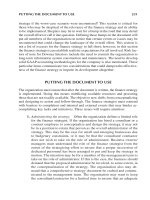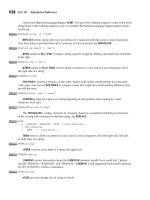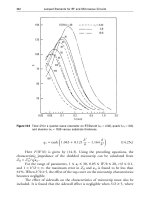security assessment case studies for implementing the nsa iam phần 10 pot
Bạn đang xem bản rút gọn của tài liệu. Xem và tải ngay bản đầy đủ của tài liệu tại đây (858.56 KB, 42 trang )
What Was Good?
Positive results should be put on your Good list.These are processes that you
might never have tried before during an assessment but that worked out well.
These include such things as the change in interview style we mentioned earlier.
Another example might be a new interviewer on the team who performed well
and can added to the list of team leaders for your company. Our goal is to iden-
tify the good attributes of our assessment process.
N
OTE
Good lessons are just as important to understand as the negatives
lessons. I’ve seen many organizations that approach the analysis of
lessons learned as a pessimistic activity that generally only points out
negative activities. This couldn’t be further from a healthy approach. The
truth of the matter is that the process needs at least as much positive
reinforcement as negative.
Consider some of the activities that might have seemed “spur of the
moment” when they were performed but eventually added value to the
assessment process. This is important because it reassures team mem-
bers that individual thought about the way our process assessment
unfolds is a good attribute. Team members with positive attitudes will
do much more to improve the process than those with negative atti-
tudes.
What Requires Improvement?
Negative results should be put on your Poor list. Negative items might include
processes that perform poorly in certain situations or the lack of a needed process
altogether.These aren’t necessarily things you’ve known about for months, which
is why we call them lessons learned.Your team will pick up these tidbits of infor-
mation through experience and from assessing a variety of customers and indus-
tries. In actuality, you should view these lessons as positive since they give the
team an opportunity to improve immature processes.
www.syngress.com
Tying Up Loose Ends • Chapter 11 389
286_NSA_IAM_11.qxd 12/16/03 1:01 PM Page 389
Utilizing Lessons Learned
Now you’ve created these lists of the lessons you’ve learned during the assess-
ment process and you’re trying to figure out what to do with them. How do we
integrate lessons learned into the IAM? The lessons we learn during assessments,
if analyzed properly and taken advantage of, can lead to continuous process
improvement. After all, continuous improvement of our processes will create a
better product and hopefully generate more business for our company.
Integrating Lessons Learned into the Business Process
NSA does not provide information in the structure if the IATRP regarding how
organizations should integrate lessons learned.This activity is normally a business
process and should be considered unique to each organization. But there are a
few things that appear to remain the same, regardless of the organization, when
we try to integrate lessons learned.These things are:
■
Identifying lessons that provide value
■
Integrating the solution into normal procedures
■
Providing tracking of the process for future assessments
The first step is deciding which lessons learned during the assessment actually
provide value. As you analyze your lists, try to envision how each item can pro-
vide value. What does the lesson give us that we don’t have covered in other pro-
cesses? Is the lesson a result of not fully implementing or conducting processes
that already exist, or is it a totally new process that needs to be considered? If our
lesson is something that can be addressed in a process we already perform, it
probably makes sense to adjust the existing process to address our lesson. If the
process is something we haven’t previously utilized, we should consider inte-
grating it into our normal assessment procedures.
The integration of a new process can be difficult for an inexperienced assess-
ment team. New team members don’t always adjust as well as we’d like and can
forget new procedures. We know from experience that consultants in any field
are liable to work on autopilot, allowing themselves to be carried through the
process by their own habits.
To counter this possibility, the organization conducting the assessments
should consider creating methods for tracking the assessment process, including
each individual process that occurs.The easiest method for doing something like
this is to create a master checklist of activities that must be performed.As the
www.syngress.com
390 Chapter 11 • Tying Up Loose Ends
286_NSA_IAM_11.qxd 12/16/03 1:01 PM Page 390
IAM assessment progresses, each team member will find themselves responsible
for different pieces of the assessment process. If we include processes designed to
address previous lessons learned, we ensure that each process is seen and
addressed by the team members.A sample checklist is shown in Figure 11.3.
NOTE
Figure 11.3 is not a complete checklist but instead provides a sample of
what can be done to track assessment activities. The actual document
used should be customized to your organization’s own
Figure 11.3 Sample Assessment Checklist
Customer Mission and Data:
1. The assessment team and the customer have come to an
understanding of:
■
The scope of the assessment
■
The way the assessment process works
■
The level of detail required in recommendations
Document name/location:____________________________________
2. The assessment team understands the customer mission,
goals, and objectives.
Document name/location:____________________________________
3. The assessment team and the customer have defined the types
of information the customer processes.
Document name/location:____________________________________
4. The assessment team and the customer have come to an
understanding as to the perceived value of the customer data
and information to the customer.
Document name/location:____________________________________
Customer Criticality Matrices:
5. The assessment team and the customer have determined what
information is critical to the customer mission and the systems
containing that data.
Document name/location:____________________________________
www.syngress.com
Tying Up Loose Ends • Chapter 11 391
Continued
286_NSA_IAM_11.qxd 12/16/03 1:01 PM Page 391
Figure 11.3 Sample Assessment Checklist
6. The assessment team has worked with the customer to define
the impact values associated with the OICM.
Document name/location:____________________________________
7. The defined impact values have been assigned to the customer
data areas defined in Step 5 in relation to loss of CIA.
Document name/location:____________________________________
8. The sum of organizational criticality has been determined and
documented.
Document name/location:____________________________________
Making It Repeatable
Another advantage of using a checklist similar to the example in Figure 11.3 is
that it will also help keep the process repeatable.The repetition of each step
through every assessment is key for maintaining a mature and reliable assessment
process.Team members who have been doing assessments for a while don’t nor-
mally have many questions about the process.They’ll be comfortable with the
methods the organization uses to assess customers. New team members, however,
need guidance to ensure a high-quality final product for the customer. Processes
may seem foreign or new to these members.
Consider the confusion new consultants may encounter when they first start
using your organization’s methodology. One method for countering this learning
curve is to add an easy-to-follow checklist that provides a foundation for assess-
ment activities.This allows newer team members to gain a better understanding
of the events that are supposed to occur within the assessment. In the end, the
customer will have a higher-quality product and your team members will be
more confident in their work. Hopefully this will also contribute to a more pro-
ductive and cohesive team environment.
Certainly there are other methods for ensuring that the processes are repeat-
able. Creating standard processes and documenting these processes, in some form
or another, will aid in creating an environment or repetition. Whether you use a
checklist similar to the example in Figure 11.3 or you create something totally
new, standardizing your activities will ensure that each assessment is conducted
similarly, all team members are comfortable with the way the assessment is con-
ducted, and the customer receives the same level of service regardless of what
individuals are on the team.
www.syngress.com
392 Chapter 11 • Tying Up Loose Ends
286_NSA_IAM_11.qxd 12/16/03 1:01 PM Page 392
WARNING
The value of repeatable processes cannot be overstated. Organizations
such as the ISO have created criteria and certification programs for orga-
nizations that want to improve and demonstrate their ability to continue
functioning. Repeatable processes and the documents that define these
processes are key. Having the ability to maintain a higher level of perfor-
mance over an extended period of time indicates maturity within the
business and assures customers that they will receive the same level of
product and service.
Case Study: The University of Science
The University of Science is a typical higher education institution focused on
providing return value to the various industries the university supports through
education, research, and development. Our organization was contracted several
months ago to provide an IAM-based assessment of this educational institution.
The assessment process went well and uncovered a large number of issues of
which the customer was not previously aware.
Understanding the Requirements
According to our contract and statement of work with the customer, we did not
have an obligation to provide document retention services.The customer had not
expressed an interest in the service until the assessment was in full swing.The
problem was that our company does not offer this service as a core competency.
In order to help the customer in this area, we recommended a partner com-
pany to the customer. Our partner has been providing these services for the past
five years as part of its business continuity offering.The partner was appropriately
equipped and able to offer this service to our client. But the piece of this recom-
mendation that we could help the customer with concerns deciding what docu-
mentation should be kept and what documentation should be destroyed.
What Should We Keep?
Initially, we concentrated on those documents that should be retained as part of
the security trend for the customer organization. We recommended that the final
report be retained as part of a good security program because it provides legacy
www.syngress.com
Tying Up Loose Ends • Chapter 11 393
286_NSA_IAM_11.qxd 12/16/03 1:01 PM Page 393
information on where the customer organization began addressing security and
its progress thus far.The technical information and recommendations belong to
the customer. Retaining this information depends heavily on the customer goals
regarding the information. In this situation, the customer decided that once cur-
rent findings have been resolved, the technical information will be retained as
legacy documentation. All documents will be kept for three years to provide his-
torical data for future assessment efforts.
What Should We Destroy?
The decision about what documents would be destroyed was relatively easy.The
customer already had copies of all the standards and regulations used during the
assessment process.Those documents could be destroyed since no new versions
of those documents were released.The documents we created during the assess-
ment in relation to our interviews were to be destroyed.The NSA IAM teaches
that any notes taken during the assessment process should remain anonymous in
order to keep the assessment process in a state of nonattribution.The customer
was made aware of these issues during the development of the statement of
work. According to our contract with the customer, the interview notes would
be destroyed.The only exception is the information in the final report, which
was combined from all the individual sources.
Designating a Followup POC
Since the delivery of the final report at the beginning of last week, we haven’t
heard back from the customer. We’ve about reached the point when we need to
consider following up with the customer.The team leader previously designated
the POC for each area of the assessment and now gives the go-ahead to each
team member to begin the followup process.
The team POCs were selected based on their knowledge of the subject areas
we dealt with during this assessment. Mike was selected to provide followup on
the disaster recovery area because he has years of experience in this area and
should be able to provide knowledgeable help to the customer. Sarah was chosen
to follow up regarding the UNIX heavy environment at the customer location.
The team leader will follow up with the customer POC concerning any issues
or questions related to the final report, its format, or any other assessment-related
questions.
www.syngress.com
394 Chapter 11 • Tying Up Loose Ends
286_NSA_IAM_11.qxd 12/16/03 1:01 PM Page 394
What Have We Learned?
Our last step is to analyze the lessons we learned during the assessment process.
As in most assessments, some of our lessons learned are positive, others are of a
more negative nature.The team leader lists the lessons learned in order to eval-
uate their eventual value to our assessment process.All the team members have
the freedom to submit issues as lessons learned. Each lesson is then analyzed one
by one to determine its value and relevance to our assessment process.
Our lessons learned include a new report format that seems a better fit for
the assessment work being performed and a method of holding interviews in a
group setting.The team sits down together to judge the value of these two
lessons.The new suggested report format is actually just an expansion of what is
already being done.The value provided is the customer’s clearer understanding of
report findings.The team agrees to integrate this lesson into future assessments by
including the new information in the template for our final reports.
The second lesson deals with holding group interviews for the user commu-
nity at large organizations.This allows us to get a better overall feel for the actual
understanding of the customer security environment while making it clear to
users that if there are concerns, they can contact the team offline to discuss the
issues in private.The team discusses this second lesson and determines that this
activity already occurs and does not require integration into the current assess-
ment process.
www.syngress.com
Tying Up Loose Ends • Chapter 11 395
286_NSA_IAM_11.qxd 12/16/03 1:01 PM Page 395
Summary
Document retention is not directly covered in the NSA IAM beyond simply
stating that the information is customer proprietary and does not belong to the
organization conducting the assessment. If you’re performing these assessments,
consider all documentation sensitive. Documents should never be held by the
assessing organization beyond a 90-day period.This time period enables you to
answer any customer concerns or questions.
Special conditions may exist where the customer has asked you to provide
document retention services.There is a significant level of liability associated
with maintaining sensitive documentation regarding customer security postures.
Special storage requirements may exist, such as physical security concerns, storage
space, and file system security. Other concerns include the backup and restora-
tion of this information for business continuity purposes or understanding the
ramifications of a compromise of customer data on your organization.The long-
term retention of sensitive customer information is discouraged unless this is a
core competency of your organization and is not covered by NSA in the IAM
training course.
Following up with the customer is a highly valuable activity. It can lead to
answers to questions the customer might not have been capable of asking directly
or questions they might not have asked for fear of sounding unintelligent.These
activities are not covered directly by the NSA IAM beyond stating that followup
is necessary.
To ensure the highest quality of followup with the customer, the team
member performing the activity needs to show appropriate concern for the cus-
tomer’s situation. Remember to be tactful in all your dealings with the customer.
Don’t make statements that can be misconstrued or misinterpreted.Try to remain
friendly during the process. Assessments can be frustrating, but keep in mind that
the customer is paying the bill and will likely talk to friends and colleagues con-
cerning the assessment.Your ability to provide responsive and caring followup
could provide opportunities for more work.
Although not addressed in detail by NSA during the IAM training, the pro-
cess of evaluating lessons learned is important for ensuring the continuing
growth and evolution of your assessment services. Lessons can be negative or
positive and should be integrated into your processes only if they provide ade-
quate value. In some cases, lessons can be integrated into processes that already
partially meet our requirements.
www.syngress.com
396 Chapter 11 • Tying Up Loose Ends
286_NSA_IAM_11.qxd 12/16/03 1:01 PM Page 396
Best Practices Checklist
Examining Document Retention
Understand the contract requirements for document retention.
Understand the liability for accepting responsibility for document
retention.
Organize your documentation by areas: public domain, customer, and
generated.
Consider the security requirements of retaining sensitive documentation.
Look into alternatives and partnerships if document retention is not a
core competency of your business.
Performing Customer Followup
Followup is a great method for eliminating customer confusion and
ensuring customer satisfaction.
Express genuine concern for the issues the customer is facing.
Ask the right questions to obtain useful answers. Consider creating a
baseline list of questions to begin the followup process.
Designate responsible team members for each portion of the fol-
lowup process, and communicate the information to the team to
ensure they’re prepared.
Track the followup process to ensure that no customer questions or
concerns fall through the cracks.
Evaluating Lessons Learned
Analyzing the lessons we learn during the assessment process helps
create maturity within the process.
Lessons we learn during each assessment can be either positive or
negative.
www.syngress.com
Tying Up Loose Ends • Chapter 11 397
286_NSA_IAM_11.qxd 12/16/03 1:01 PM Page 397
Negative lessons indicate areas that need improvement or enhance-
ment.
Positive lessons promote team involvement and assessment process
evolution.
Integrate the lessons that provide value into the overall assessment
process so that they will continue to be used in future endeavors.
Q: Does your company provide document retention services, and if not, why
not?
A: Document retention is simply not one of our core competencies, and until
we decide to focus on that business area, we’re ill equipped to deal with the
logistics or legalities of storing sensitive customer information. When cus-
tomers inquire about this service, we refer them to partner entities that focus
on this area and can provide better value. From a business perspective, this
strategy allows us to remain strong in those areas we’re best at without get-
ting sidetracked just to earn a dollar.
Q: Does followup need to be performed on every size of customer organization,
or should we really only concentrate on larger customers?
A: As a business, we do follow up with every customer organization, regardless
of size. In the end this is really a business decision, but we don’t feel that
smaller customers are any less important than our larger customers. It’s takes a
little extra time and it can be uncomfortable sometimes, but it’s worth it
when the customer is satisfied with the results.
Q: The example you give for an assessment checklist seems pretty generic. Do
you know of any better examples?
www.syngress.com
398 Chapter 11 • Tying Up Loose Ends
Frequently Asked Questions
The following Frequently Asked Questions, answered by the authors of this book,
are designed to both measure your understanding of the concepts presented in
this chapter and to assist you with real-life implementation of these concepts. To
have your questions about this chapter answered by the author, browse to
www.syngress.com/solutions and click on the “Ask the Author” form. You will
also gain access to thousands of other FAQs at ITFAQnet.com.
286_NSA_IAM_11.qxd 12/16/03 1:01 PM Page 398
A: We provide a generic example just to convey the idea of what a checklist
should cover. What you create in your business depends heavily on how your
organization conducts these assessments. It’s never smart to simply cut and
paste someone else’s checklist into your own processes, since your require-
ments are most likely different from those of your competitor.
Q: Have you run into situations where the customer has expressed distinct con-
cerns but your team finds it difficult to get in touch with the customer to
help resolve the concerns? If so, how did you deal with the situation?
A: Yes, there will always be customers that have too much going on in their
everyday business world.The resolution of assessment concerns often loses
priority because the customer has to face more pressing issues on a daily
basis. We like to continue trying to resolve the issues for as long as possible.
We use calls to the customer’s desk phone and cell phone and e-mail mes-
sages in the majority of cases to attempt to make contact. In some limited
cases we’ll use postal mail to contact the customer, but this tends to be
tedious and extremely slow for a timely assessment process. In the end it’s
really up to the customer to respond to your offers of help.
Q: Can an assessing organization legitimately make decisions about what docu-
ments should be kept or destroyed?
A: No.You cannot make any decisions for the customer during an IAM-based
assessment.The customer knows best about their own business, but your team
should provide guidance and expertise on procedures that should be consid-
ered. When it comes to document retention or destruction, you can make
recommendations to the customer, but the final decision should be the cus-
tomer’s to make.
Q: Can a single team member be the POC for multiple areas of the assessment
process?
A: Yes.The members of the assessment team should be able to cover multiple
areas of knowledge within the assessment process. For example, there is a
good chance that the team member with Windows or UNIX experience
will likely have network knowledge as well.Assigning that team member the
responsibility of following up with the customer in those two areas is not
uncommon.
www.syngress.com
Tying Up Loose Ends • Chapter 11 399
286_NSA_IAM_11.qxd 12/16/03 1:01 PM Page 399
286_NSA_IAM_11.qxd 12/16/03 1:01 PM Page 400
Forms, Worksheets,
and Templates
NOTE
In addition to copying the documents available on the
next few pages, you can download versions of the docu-
ments from the Syngress Solutions Web site for the title
Security Assessment: Case Studies for Implementing the
NSA IAM.
Appendix A
401
286_NSA_IAM_AppA.qxd 12/16/03 12:37 PM Page 401
IAM Pre-Assessment Site Visit Checklist
Organization Name: Date:
Assessment Team Leader: Assessment Team Members:
Organization Primary Point of Contact (POC):
Title
Address
Desk Phone
Mobile Phone/Pager
Organization Representative:
Title
Address
Desk Phone
Mobile Phone/Pager
Organization Representative:
Title
Address
Desk Phone
Mobile Phone/Pager
Organization Representative:
Title
Address
Desk Phone
Mobile Phone/Pager
www.syngress.com
402 Appendix A • Forms, Worksheets, and Templates
286_NSA_IAM_AppA.qxd 12/16/03 12:37 PM Page 402
Preparation
1. IAM Planning Survey Customized and delivered
to client?
Received and reviewed?
2. Travel Arrangements Air?
Hotel?
Car?
3. Team Composition: Technical personnel available
Technical and scheduled?
4. Team Composition: Industry-knowledgeable
Industry personnel available and
scheduled?
5. Customer Scheduling All appropriate customer
personnel available and
scheduled for visit?
Consideration
In this section, record customer expectations or concerns and describe
relevancy to assessment.
Organizational Expectations
1.
2.
3.
Activities
1. Mission Identification Understood and documented
as pertaining to security.
2. Organizational Performed and documented
Information Criticality with organization.
3. System Information Performed and documented
Criticality with organization.
4. System Security Documented and verified with
Environment organization.
5. System Security Plan Documented, approved, and
authorized by organization.
6. Definition of Goals/Objectives
www.syngress.com
Forms, Worksheets, and Templates • Appendix A 403
286_NSA_IAM_AppA.qxd 12/16/03 12:37 PM Page 403
IAM Planning Survey
Organization Name: Date:
The purpose of this survey is to collect information relating to a target orga-
nization and system in order to prepare for an IAM assessment. Please com-
plete this document to the best of your ability, answering questions as briefly,
yet as completely, as possible. If you have questions regarding this process,
please contact your appointed representative at the phone number or e-mail
address listed below.
Assessment Team Point of Contact (POC):
Title
Address
Desk Phone
Mobile Phone/Pager
Organization Primary Point of Contact (POC):
Title
Address
Desk Phone
Mobile Phone/Pager
Organizational Environment
For this section, please describe aspects of your internal organizational
environment.
1. How many physical locations
do you have?
2. Do you believe there will be
a need for travel to remote
sites? If so, how many of them?
3. Do you currently outsource any
functions of IT? If so, what
functions?
4. Do you have an IT Security
department? If so, what
positions are included?
www.syngress.com
404 Appendix A • Forms, Worksheets, and Templates
286_NSA_IAM_AppA.qxd 12/16/03 12:37 PM Page 404
5. How many employees are
located at each site?
6. Please list any organizational
information you feel pertinent
to the assessment that might
not have been requested.
Information Technology (IT) Environment
For this section, please describe aspects of your infrastructure architecture.
1. What networking protocols are
in use? (TCP/IP, SNA, IPX/SPX, etc.)
2. What network elements (NE) are
in use? (Cisco, 3COM, Foundry, etc.)
3. What types of mainframe or
terminal-based systems are
in use?
4. What server-level operating
systems (OSs) are in place?
(Windows, Novell, Solaris, etc.)
5. How many server-level systems
are located at each site?
6. What desktop-level Oss are
in place?
(Windows, Mac, Linux, etc.)
7. How many desktop-level
systems are located at each site?
8. What services are made available
externally? (FTP, HTTP, SMTP, etc.)
9. What applications support
external services?
(Exchange, Netscape, Apache)
10. What services are made available
internally? (FTP, HTTP, SMTP, etc.)
11. What applications support
internal services?
(Exchange, Netscape, Apache)
12. What remote access is permitted,
and through what medium?
(ISDN, RAS, VPN, etc.)
www.syngress.com
Forms, Worksheets, and Templates • Appendix A 405
286_NSA_IAM_AppA.qxd 12/16/03 12:37 PM Page 405
13. What internal domain
structuring is in use?
(NT Domain, AD, NDS, etc.)
14. What wireless technology is in
use? (802.11, Bluetooth, etc.)
15. Are any third-party connections
in place? (Customer, partner, etc.)
16. Is Voice over IP (VoIP) in use?
17. Is converged network
architecture implemented?
18. Please list any infrastructure
information you feel is pertinent
to the assessment that might
not have been requested.
Technical Security Environment
For this section, please describe aspects of your infrastructure architecture.
1. Are boundary firewalls in place?
(Raptor, PIX, Checkpoint, etc.)
2. Are firewalls used internally
for compartmentalization?
3. What intrusion detection systems
(IDSs) are in use?
(Real Secure, Snort, etc.)
4. What types of IDS agents are
used? (Network, host, or hybrid)
5. What types of encryption,
strength, and methods
are in use?
(WEP, HTTPS, PKI, 3-DES, etc.)
6. What types of centralized
security have been implemented?
(SecureLogin, BindView, etc.)
7. What types of added identification
authentication measures
are in use?
(Token, digital signature, etc.)
www.syngress.com
406 Appendix A • Forms, Worksheets, and Templates
286_NSA_IAM_AppA.qxd 12/16/03 12:37 PM Page 406
8. Please list any infrastructure
information you feel is pertinent
to the assessment that might
not have been requested.
Industry Guidance Environment
For this section, please respond in accordance with any and all legislation,
regulation, or guidance the organization is compelled to comply with.
1. Health Insurance Portability
and Accountability Act (HIPAA) Yes No
2. Gramm-Leach-Bliley (GLB) Yes No
3. Financial Management and
Accountability Act (FMA Act) Yes No
4. Sarbanes-Oxley Yes No
5. Family Educational Rights
and Privacy Act (FERPA) Yes No
6. Federal Information Security
Management Act (FISMA) Yes No
7. National Institute of Standards
and Technologies (NIST) Yes No
8. Please list any and all local, state,
and federal regulations the
organization is obligated to
comply with (PDD-63, OMB A-130,
FIPS, Clinger-Cohen Act)
9. Please list all guidelines followed
but not previously mentioned
www.syngress.com
Forms, Worksheets, and Templates • Appendix A 407
286_NSA_IAM_AppA.qxd 12/16/03 12:37 PM Page 407
Types of Documents
That Require Tracking
This section presents samples of documents an assessment team needs to perform
an assessment.This section is designed to provide a guide for some of the titles
that we have seen. Specific naming of documents is organizationally dependent,
so this list may not include all the names you may encounter. All documents
should be logged on a simple document-tracking sheet.
Policy Documents
■
Acceptable-Use/Internet Usage Policy
■
Business Strategy
■
Corporate Mission
■
Employee Code of Conduct
■
Information Security Policy
■
Information Systems Security Policy
■
Internet Usage Policy
■
IT Strategy
■
Mission Statement
■
Organization Chart
■
Organizational Description
■
Organizational Security Policy/Procedures
■
Personnel Security Policy
■
Physical Security Policy
■
Security Policy
■
Security Strategy
■
Strategy Document
www.syngress.com
408 Appendix A • Forms, Worksheets, and Templates
286_NSA_IAM_AppA.qxd 12/16/03 12:37 PM Page 408
Guideline/Requirements Documents
■
Administrative Security Requirements (Marking, Labeling, Storage,
Transport of Documentation and Removable Media)
■
Business Continuity/DRP
■
Communications Security (COMSEC) and COMSEC Key
Management Procedures
■
Concept of Operations (CONOPs)
■
HR Procedures (Hiring,Transfer, Retirement,Termination)
■
List and Description of HW, SW, FW, OS, DB, GOTS, COTS,
DOI/NBC Unique Applications
■
Maintenance Standards/Change Control
■
Mission Needs Statement (MNS)
■
Network Connection Rules (External)/ External Connection
MOU/MOA
■
Operational Requirements Document (ORD)
■
Security Concept of Operations (SECCONOPS)
■
Security Department/Committee Mandates
■
Security Programming/Testing Standards
■
Technical Standards/Guidelines
System Security Plan Documents
■
Contingency Plan/Continuity of Operations Plan (COOP)
■
Configuration Management Plan
■
Network Diagrams/Architecture with Narrative
■
Network Diagram (High and Low Level) Required
■
Personnel Security Plan
■
Physical Security Plan
■
Prior Assessment (Threat/Risk/Security)
www.syngress.com
Forms, Worksheets, and Templates • Appendix A 409
286_NSA_IAM_AppA.qxd 12/16/03 12:37 PM Page 409
■
Prior Audits (Internal or External)
■
System Security Authorization Agreement (SSAA)
■
Security Test Plans
User Documents
■
Account Management and Data Transfer Procedures in Hiring,Transfer,
Retirement,Termination
■
Audit Procedures
■
Data Backup Procedures
■
Desktop Support Security Procedures
■
Desktop Support End-User Security Awareness
■
Identification and Authentication Procedures
■
Incident Response Plan
■
Maintenance Plan/Procedures
■
Password Management Procedures
■
Personnel Security Procedures
■
Physical Security Procedures
■
Security Administrator Procedures
■
Security Administrator’s Manual
■
Security Education Awareness Training Plan
■
Security Features User’s Guide
■
Server/OS Administration Procedures
■
Standard Operating Procedures (SOPs)
■
Systems Admin Professional Development
■
Systems Admin Security Procedures
■
User’s Guide
■
Vendor Documentation
■
Virus/Malicious Code Protection
www.syngress.com
410 Appendix A • Forms, Worksheets, and Templates
286_NSA_IAM_AppA.qxd 12/16/03 12:37 PM Page 410
Document-Tracking Templates
Date
Date Date Destroyed or
Title Requested Received Custodian Returned
Signatory Version Update Pages
Version Date Approval Information Affected
www.syngress.com
Forms, Worksheets, and Templates • Appendix A 411
286_NSA_IAM_AppA.qxd 12/16/03 12:37 PM Page 411
Elements of the
Technical Assessment Plan
The following are elements that you may find helpful when creating your TAP.
However, we encourage you to thoroughly read Chapter 6, “Understanding
the Technical Assessment Plan,” to gain a further understanding and prescrip-
tive advice regarding the format of your customized TAP.
Customer Organization Contacts
Primary Point of Contact:
Title
Address
Desk Phone
Mobile Phone/Pager
Alternate Point of Contact:
Title
Address
Desk Phone
Mobile Phone/Pager
www.syngress.com
412 Appendix A • Forms, Worksheets, and Templates
286_NSA_IAM_AppA.qxd 12/16/03 12:37 PM Page 412
Assessment Team Organization Contact
Primary Point of Contact:
Title
Address
Desk Phone
Mobile Phone/Pager
Alternate Point of Contact:
Title
Address
Desk Phone
Mobile Phone/Pager
The Interview List
Interviewee Title Address/Location Phone/E-mail
www.syngress.com
Forms, Worksheets, and Templates • Appendix A 413
286_NSA_IAM_AppA.qxd 12/16/03 12:37 PM Page 413

